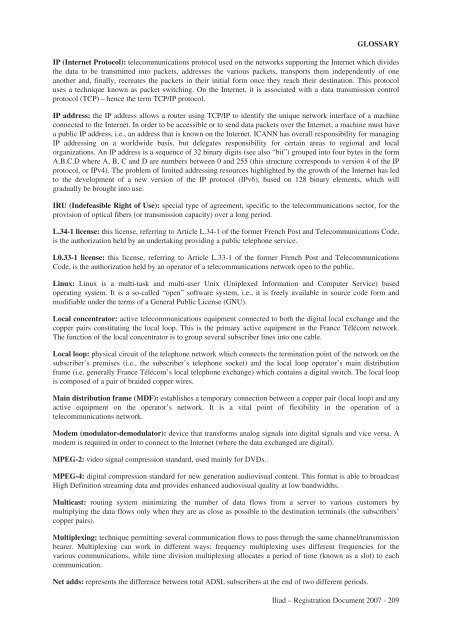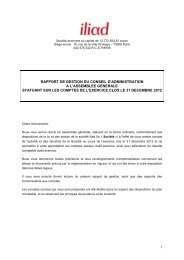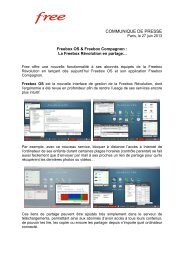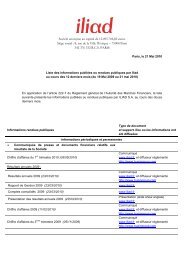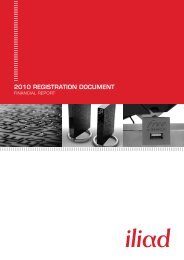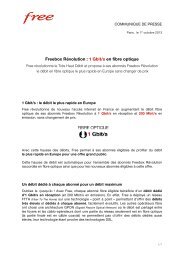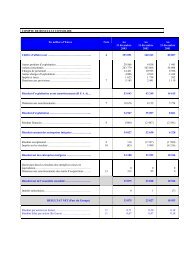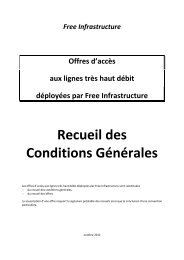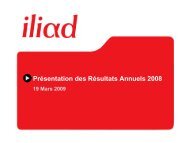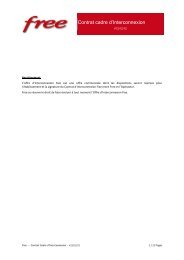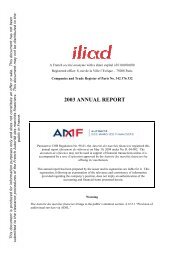REGISTRATION DOCUMENT AND FINANCIAL REPORT - Iliad
REGISTRATION DOCUMENT AND FINANCIAL REPORT - Iliad
REGISTRATION DOCUMENT AND FINANCIAL REPORT - Iliad
- TAGS
- registration
- iliad
- iliad.fr
Create successful ePaper yourself
Turn your PDF publications into a flip-book with our unique Google optimized e-Paper software.
GLOSSARY<br />
IP (Internet Protocol): telecommunications protocol used on the networks supporting the Internet which divides<br />
the data to be transmitted into packets, addresses the various packets, transports them independently of one<br />
another and, finally, recreates the packets in their initial form once they reach their destination. This protocol<br />
uses a technique known as packet switching. On the Internet, it is associated with a data transmission control<br />
protocol (TCP) – hence the term TCP/IP protocol.<br />
IP address: the IP address allows a router using TCP/IP to identify the unique network interface of a machine<br />
connected to the Internet. In order to be accessible or to send data packets over the Internet, a machine must have<br />
a public IP address, i.e., an address that is known on the Internet. ICANN has overall responsibility for managing<br />
IP addressing on a worldwide basis, but delegates responsibility for certain areas to regional and local<br />
organizations. An IP address is a sequence of 32 binary digits (see also “bit”) grouped into four bytes in the form<br />
A.B.C.D where A, B, C and D are numbers between 0 and 255 (this structure corresponds to version 4 of the IP<br />
protocol, or IPv4). The problem of limited addressing resources highlighted by the growth of the Internet has led<br />
to the development of a new version of the IP protocol (IPv6), based on 128 binary elements, which will<br />
gradually be brought into use.<br />
IRU (Indefeasible Right of Use): special type of agreement, specific to the telecommunications sector, for the<br />
provision of optical fibers (or transmission capacity) over a long period.<br />
L.34-1 license: this license, referring to Article L.34-1 of the former French Post and Telecommunications Code,<br />
is the authorization held by an undertaking providing a public telephone service.<br />
L0.33-1 license: this license, referring to Article L.33-1 of the former French Post and Telecommunications<br />
Code, is the authorization held by an operator of a telecommunications network open to the public.<br />
Linux: Linux is a multi-task and multi-user Unix (Uniplexed Information and Computer Service) based<br />
operating system. It is a so-called “open” software system, i.e., it is freely available in source code form and<br />
modifiable under the terms of a General Public License (GNU).<br />
Local concentrator: active telecommunications equipment connected to both the digital local exchange and the<br />
copper pairs constituting the local loop. This is the primary active equipment in the France Télécom network.<br />
The function of the local concentrator is to group several subscriber lines into one cable.<br />
Local loop: physical circuit of the telephone network which connects the termination point of the network on the<br />
subscriber’s premises (i.e., the subscriber’s telephone socket) and the local loop operator’s main distribution<br />
frame (i.e. generally France Télécom’s local telephone exchange) which contains a digital switch. The local loop<br />
is composed of a pair of braided copper wires.<br />
Main distribution frame (MDF): establishes a temporary connection between a copper pair (local loop) and any<br />
active equipment on the operator’s network. It is a vital point of flexibility in the operation of a<br />
telecommunications network.<br />
Modem (modulator-demodulator): device that transforms analog signals into digital signals and vice versa. A<br />
modem is required in order to connect to the Internet (where the data exchanged are digital).<br />
MPEG-2: video signal compression standard, used mainly for DVDs.<br />
MPEG-4: digital compression standard for new generation audiovisual content. This format is able to broadcast<br />
High Definition streaming data and provides enhanced audiovisual quality at low bandwidths.<br />
Multicast: routing system minimizing the number of data flows from a server to various customers by<br />
multiplying the data flows only when they are as close as possible to the destination terminals (the subscribers’<br />
copper pairs).<br />
Multiplexing: technique permitting several communication flows to pass through the same channel/transmission<br />
bearer. Multiplexing can work in different ways: frequency multiplexing uses different frequencies for the<br />
various communications, while time division multiplexing allocates a period of time (known as a slot) to each<br />
communication.<br />
Net adds: represents the difference between total ADSL subscribers at the end of two different periods.<br />
<strong>Iliad</strong> – Registration Document 2007 - 209


